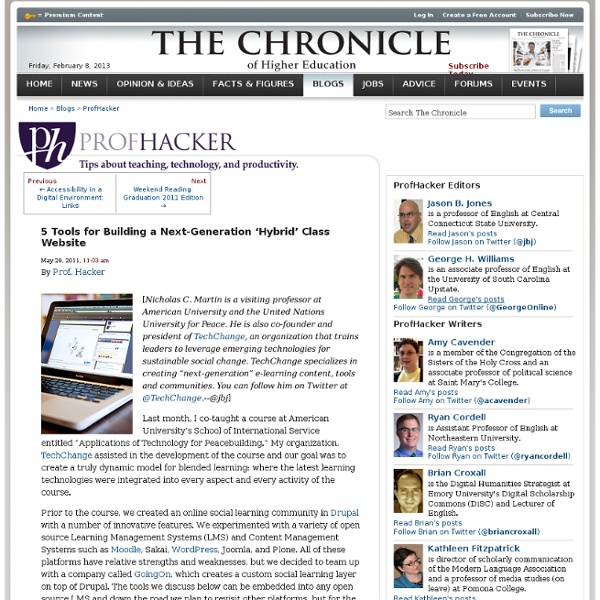100+ Online Resources That Are Transforming Education
Yury Lifshits is working on algorithms and prototypes of new services at Yahoo! Research. Before that he was teaching university courses in the U.S., Germany, Russia and Estonia.
10 Questions to consider
Ten Questions to consider when redesigning a course for hybrid teaching and learning A hybrid or blended course, by definition, reduces face-to-face "seat time" so that students can pursue additional teaching and learning activities online. To be successful, a hybrid or blended course requires careful pedagogical redesign.
7 Ingenious Resumes That Will Make You Rethink Your CV
You love resumes. You really do. When we published "10 Creative Social Media Resumes To Learn From" in May, our readers enthusiastically responded by sharing it with friends, commenting on it and sending us links to their own snazzy resumes. We sifted through those links, picked our favorites and placed them in the gallery below. After clicking through the collection of resumes, were you inspired? What works for you in your industry?
First Rapid Release Firefox Beta Now Available
Mozilla is pleased to release a new Firefox Beta for download and testing. Mozilla recently introduced the Firefox Aurora development channel to support more frequent releases. The shift to a rapid release development cycle delivers cutting edge Firefox features, performance enhancements, security updates and stability improvements to users faster. After five weeks of testing on the Firefox Aurora channel, the next version of Firefox is ready for the beta channel. This release includes the Firefox channel switcher, performance and stability enhancements and support for the new CSS Animations standard to allow developers build more amazing Web experiences.
Hybrid Courses: Faculty Development
Suggested Topics There are numerous topics that could be covered in a hybrid course faculty development program. Typically, faculty have to modify their approach to teaching, manage their own and students' expectations regarding hybrid learning, integrate face-to-face and online teaching environments, learn new communication skills, develop new ways to assess student learning, master new technologies, and much more. A list of all the possible topics for an effective faculty development program would be very long. However, based upon experiences of the UWM Learning Technology Center, the following is a short list of a dozen primary issues and topics, which should form the core of any program preparing faculty for hybrid teaching.
End Technology Training? – Learn. Teach. Engage.
Ummm…no. Had to get that out of the way before I could continue. Now let me back up a little…
50 Awesome Ways to Use Skype in the Classroom
Written By: Jillian Terry Skype is a free and easy way for teachers to open up their classroom and their students to a world way beyond their campus. With Skype, students can learn from other students, connect with other cultures, and expand their knowledge in amazing ways. Teachers and parents can also benefit from Skype in the classroom. Read below to learn how you can take advantage of the power of Skype in your classroom. Promoting Education
13 Enlightening Case Studies of Social Media in the Classroom
Social media is the thing right now. It provides a way to connect people of similar (or dissimilar) interests from around the world. Social media also provides networking tools for professionals and even for job hunters. And it offers a platform for friends and family to keep up with each other. But social media isn’t just for professionals, computer geeks and families who prefer not to send email; increasingly, social media is becoming a part of the classroom. It is possible to use social media in such a way as to enhance the learning environment, and to provide an education.
41 Websites for Teachers to Integrate Tech into Your Classroom « Ask a Tech Teacher
Any cookies on my website are used to ensure normal website functions (for instance, Youtube videos won’t work without their own identifiers). These cookies cannot be switched off because the website wouldn’t work properly anymore. However, these identifiers do not store any personal data.
Top 6 Sites that Inspire and Educate
If you’re a professional who likes to be intellectually stimulated and you enjoy keeping up with the latest news and breaking trends, the internet provides you with an endless choice of carefully curated sites to visit. Today, we bring you six of them that we believe are leaps and bounds above the rest. These sites will not only educate you on topics ranging from business and technology to art and design, they’ll motivate you to find your own, original ideas and see them through.
7 Reasons To Leverage Social Networking Tools in the Classroom
Instructional uses of social networking software can provide opportunities for learning, connecting, and engagement. This year, I’ve written frequently about popular social media tools, and education-specific social networking apps, and social enterprise solutions. I’ve also noticed increasing coverage of this topic in the media recently. Maybe it’s just me paying more attention to it … or maybe it signals an increasing acceptance of these types of tools as legitimate and effective resources for the classroom. Social networking tools aren’t going away any time soon, they appear to be here for the long term. But do these kinds of applications really belong in the classroom?


